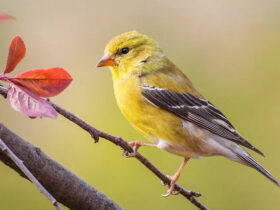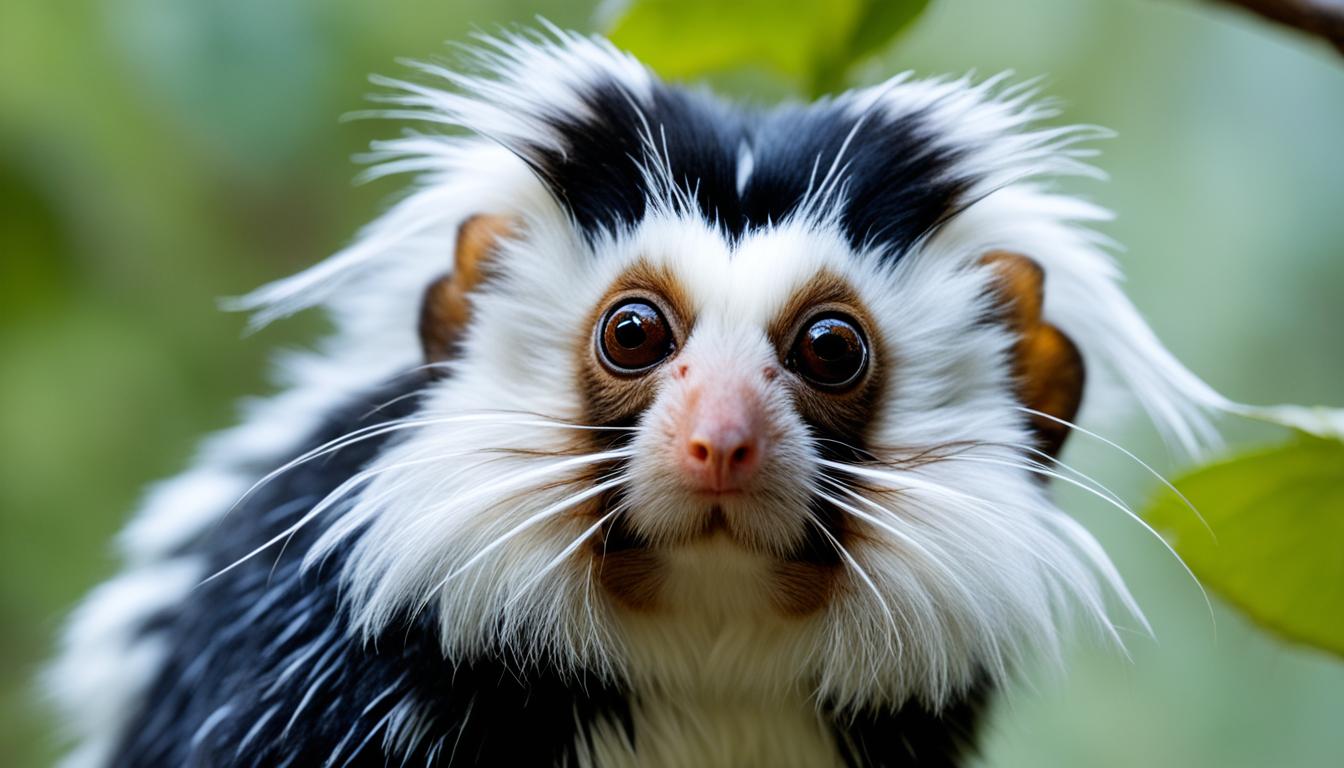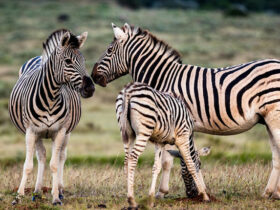Welcome to our comprehensive white tufted marmoset facts and care guide. In this article, we will take you on a journey to discover the intriguing world of this unique primate species from the rainforests of South America. From its defining characteristics to its endangered status, we will explore all there is to know about the elusive white tufted marmoset.
Native to the lush rainforests of South America, the white tufted marmoset, also known as the white-headed marmoset, is a captivating primate that has caught the attention of wildlife enthusiasts around the world. Its charming appearance and interesting behaviors make it a species worth learning about.
However, the white tufted marmoset faces numerous challenges in its natural habitat, including deforestation and the illegal pet trade. By understanding their habitat requirements and implementing effective conservation strategies, we can contribute to their survival in the wild.
Furthermore, if you are considering caring for a white tufted marmoset in captivity, it is crucial to ensure their well-being by providing them with the appropriate diet, housing, and enrichment activities. We will guide you through the essentials of marmoset care, so you can create a suitable environment for these fascinating creatures.
Join us as we uncover the secrets of the white tufted marmoset and embark on a journey of discovery into the rainforests of South America.
Key Takeaways:
- The white tufted marmoset is a unique primate found in the rainforests of South America.
- Conservation efforts are vital to protect the white tufted marmoset and its fragile habitat.
- Caring for a white tufted marmoset in captivity requires proper diet, housing, and enrichment.
- Understanding the behavior and social structure of marmosets can enhance their well-being.
- By learning about the white tufted marmoset, we can appreciate the importance of wildlife conservation.
Introduction to the White Tufted Marmoset
Welcome to the fascinating world of the white tufted marmoset, a captivating primate that calls the lush rainforests of South America its home. With its unique characteristics and social behavior, this rainforest animal has intrigued scientists and nature enthusiasts alike. Let's delve into the extraordinary features and adaptations of this remarkable species.
Physical Features
The white tufted marmoset, also known as a primate, boasts a compact and agile body. With a length of around 20 centimeters and weighing between 250 and 400 grams, it is relatively small in size. Its most distinctive feature is the tuft of white fur on the crown of its head, which gives it its name. This unique characteristic sets it apart from other primates in the region.
Social Behavior
The white tufted marmoset thrives in a highly social environment. These primates form small family groups consisting of a monogamous breeding pair and their offspring. Cooperation and mutual grooming are integral to their social structure and help to strengthen family bonds.
Communication among white tufted marmosets is a fascinating aspect of their behavior. They use a variety of vocalizations, including calls, whistles, and trills, to convey messages to their group members. These vocalizations play a crucial role in coordinating activities such as foraging and warning others of potential threats in their rainforest habitat.
Adaptations for Rainforest Life
To survive in the demanding rainforest environment, the white tufted marmoset has developed remarkable adaptations. Their specialized teeth allow them to feed on a wide range of food sources, including fruits, insects, and small vertebrates. Their nimble fingers and grasping hands enable them to navigate through the dense vegetation and extract food efficiently.
Another notable adaptation is their sharp claws, which aid in climbing trees and securing their footing while leaping between branches. Their excellent agility and arboreal lifestyle make them well-suited to the vertical world of the rainforest.
Did you know? The white tufted marmoset is a vital player in the rainforest ecosystem. As a seed disperser, it helps to maintain biodiversity by spreading the seeds of various plants throughout the forest.
Join us as we continue our exploration of the white tufted marmoset by delving into its habitat and conservation status. By understanding the challenges it faces in the wild, we can better appreciate the importance of protecting this fascinating primate and its delicate rainforest home.
Habitat and Conservation Status
The white tufted marmoset, a charming rainforest animal native to South America, inhabits the lush canopies of the Amazon rainforest and its surrounding regions. With its fluffy white fur and distinctive tufted ears, this endangered species is a marvel to behold in its natural habitat.
The rainforest serves as the primary home for the white tufted marmoset, providing essential resources, such as food, shelter, and protection from predators. These small primates are highly adapted to this unique ecosystem, with their nimble bodies and strong grasping hands enabling them to navigate through the dense vegetation with ease.
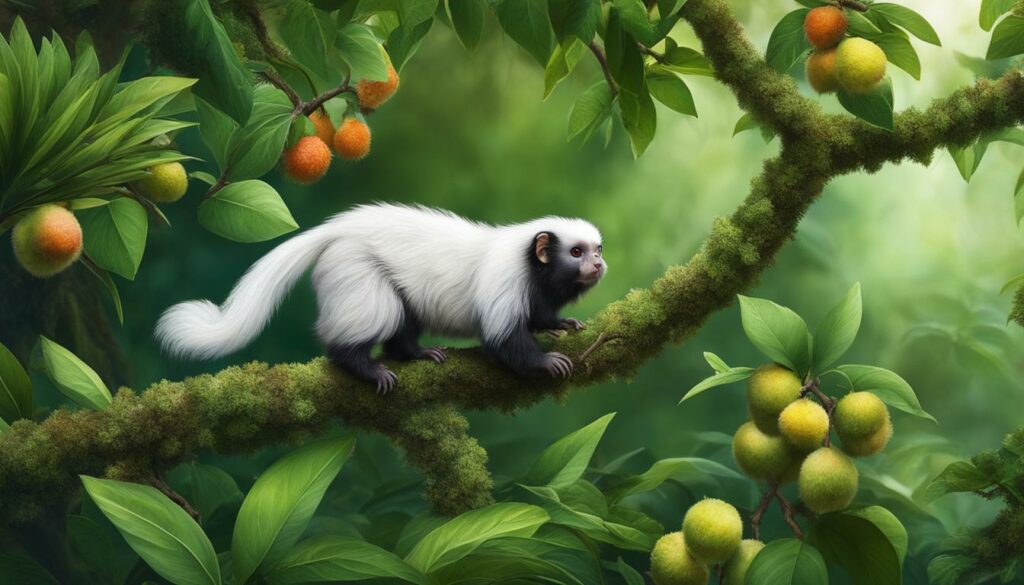
The white tufted marmoset's habitat is not only vital for their survival but also for the well-being of the entire rainforest ecosystem. As a key species within this complex web of life, they play a crucial role in seed dispersal, helping to maintain the biodiversity of the forest.
The white tufted marmoset's habitat is under threat due to deforestation, illegal wildlife trade, and the expansion of human activities in the Amazon region. As a result, their population has significantly declined, making them an endangered species.
Fortunately, wildlife conservation organizations are working tirelessly to protect the white tufted marmoset and preserve its rainforest habitat. These efforts involve raising awareness, implementing sustainable land-use practices, and establishing protected areas where these primates can thrive.
Nested Table Example
| Threats to White Tufted Marmoset | Conservation Measures |
|---|---|
| Deforestation | 1. Promoting sustainable forestry practices 2. Establishing protected areas 3. Reforestation initiatives |
| Illegal Wildlife Trade | 1. Strengthening law enforcement 2. Raising awareness about the consequences of wildlife trafficking |
| Human Activities | 1. Encouraging sustainable land-use practices 2. Educating local communities about the importance of conservation |
Through these collective efforts, we can ensure the survival of the white tufted marmoset and protect the delicate balance of the rainforest ecosystem. By supporting wildlife conservation initiatives and promoting sustainable practices, we can safeguard not only this fascinating primate but also the incredible biodiversity that lies within our rainforests.
Behavior and Social Structure
The white tufted marmoset, a captivating primate species found in the rainforests, exhibits intriguing behavior and a complex social structure.
**Primates** are known for their social nature, and the white tufted marmoset is no exception. These **monkeys** live in small family groups consisting of a breeding pair and their offspring.
An interesting aspect of their social structure is their **cooperative parenting**. Both the male and female marmosets actively participate in caring for their young. This cooperative effort helps ensure the survival and development of the offspring.
**Communication** plays a crucial role in the social interactions of white tufted marmosets. They use a variety of vocalizations, body postures, and facial expressions to convey messages within their group. This effective communication system helps them coordinate activities and maintain group cohesion.
"The white tufted marmoset's social structure and cooperative behavior highlight the importance of strong family bonds in primate communities." - Dr. Jane McKenzie, Primate Behavioral Ecologist
Another fascinating behavior displayed by these rainforest animals is their **grooming rituals**. Grooming not only fulfills hygienic needs but also reinforces social bonds among group members. It acts as a form of social bonding and helps maintain harmony within the family unit.
The white tufted marmoset's behavior and social structure demonstrate the complexity and adaptability of this primate species in their rainforest habitat. Understanding their social dynamics is essential for their well-being in both the wild and captivity.
White Tufted Marmoset Behavior and Social Structure
| Behavior | Description |
|---|---|
| Cooperative Parenting | Both male and female marmosets actively participate in caring for their young, ensuring their survival and development. |
| Communication | White tufted marmosets use vocalizations, body postures, and facial expressions to convey messages and coordinate activities within their group. |
| Grooming Rituals | Grooming serves hygienic needs and strengthens social bonds among group members, contributing to overall group harmony. |
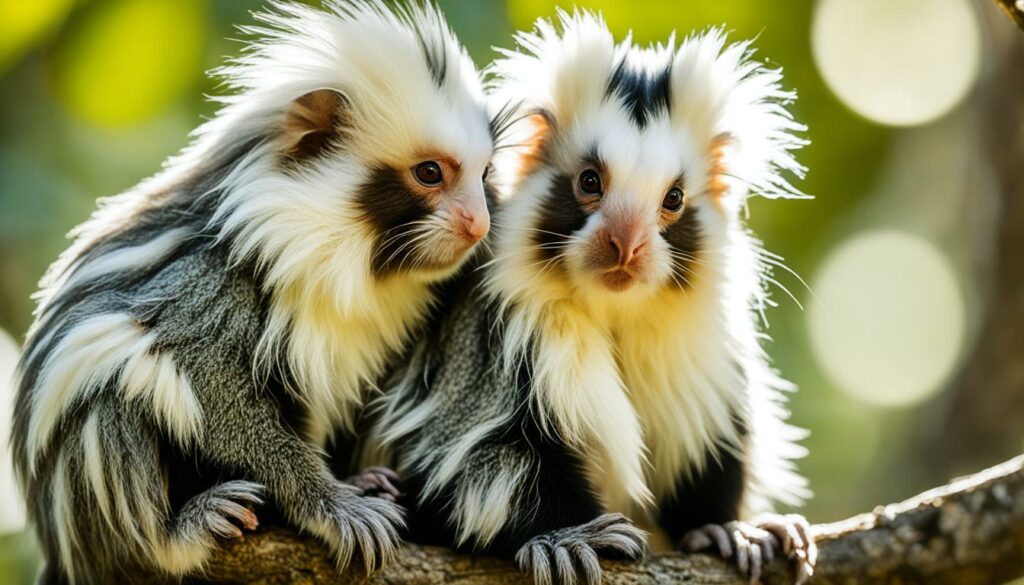
Care and Husbandry
Proper care and husbandry are crucial for ensuring the well-being of white tufted marmosets in captivity. By understanding their unique dietary requirements, suitable housing conditions, and the importance of enrichment activities, you can provide a nurturing environment that promotes their physical and mental health.
Dietary Requirements
White tufted marmosets are omnivores, meaning they eat a variety of foods. In the wild, their diet consists of fruits, flowers, nectar, tree sap, insects, and small vertebrates. To replicate their natural diet in captivity, offer a balanced and diverse menu.
- **Fruits**: Provide a selection of fresh, ripe fruits such as bananas, grapes, apples, and berries.
- **Vegetables**: Offer leafy greens, carrots, sweet potatoes, and other vegetables to ensure a well-rounded diet.
- **Protein**: Supplement their diet with small amounts of cooked eggs, lean meat, or insects like crickets and mealworms.
- **Nectar**: Include a commercial nectar supplement or a homemade mixture of honey and water, providing a source of carbohydrates.
Ensure that the food is appropriately sized and presented to mimic foraging behavior. Additionally, provide access to fresh, clean water at all times.
Suitable Housing Conditions
White tufted marmosets require spacious and enriching enclosures to thrive. Here are some essential housing considerations:
- **Space**: Provide a large enclosure with ample vertical space to encourage climbing and jumping. The minimum recommended enclosure size for a pair of marmosets is 4 feet tall, 3 feet wide, and 2 feet deep.
- **Cage Environment**: Furnish the enclosure with branches, ropes, and platforms to create a stimulating environment that simulates their natural habitat.
- **Temperature and Humidity**: Maintain a temperature range between 75°F and 85°F (24°C-29°C) with a humidity level of around 60-70% to mimic their native rainforest conditions.
Enrichment Activities
Keeping white tufted marmosets mentally stimulated and engaged is crucial for their overall well-being. Enrichment activities can include:
- **Foraging**: Hide food items within the enclosure to encourage natural foraging behaviors.
- **Toys**: Provide toys such as puzzle feeders, swinging ropes, and puzzle boxes to keep them mentally stimulated.
- **Social Interaction**: Marmosets are highly social animals, so provide ample opportunities for socialization and play with their bonded group members.
Grooming and Veterinary Care
Regular grooming is necessary to maintain the health and hygiene of white tufted marmosets. Trim their nails and check their teeth for any signs of dental issues. Additionally, schedule routine veterinary check-ups to ensure they remain in optimal health.
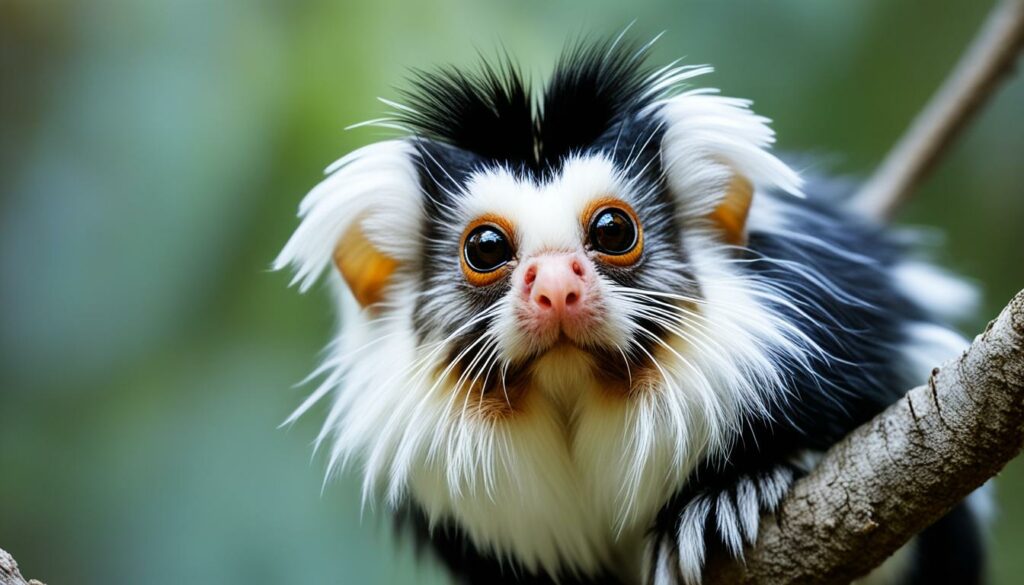
Conclusion
Throughout this white tufted marmoset facts and care guide, we have delved into the fascinating world of these unique primates. Found in the rainforests of South America, the white tufted marmoset is an endangered species that requires our attention and efforts for its conservation.
By understanding the marmoset's physical features, social behavior, and habitat, we can better appreciate its importance in the delicate ecosystem of the rainforest. Wildlife conservation plays a vital role in protecting this remarkable monkey, ensuring its survival for future generations.
Whether in captivity or in the wild, responsible care and husbandry is crucial for the well-being of this primate. Proper diet, suitable living conditions, and engaging enrichment activities contribute to their physical and mental health.
Let us cherish the beauty of the white tufted marmoset and work together to conserve its rainforest home. By supporting wildlife conservation efforts, we can make a positive impact and secure a brighter future for this incredible primate and its fragile habitat.




